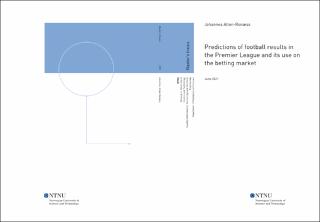| dc.contributor.advisor | Tufto, Jarle | |
| dc.contributor.author | Alten-Ronæss, Johannes | |
| dc.date.accessioned | 2021-09-24T16:00:21Z | |
| dc.date.available | 2021-09-24T16:00:21Z | |
| dc.date.issued | 2021 | |
| dc.identifier | no.ntnu:inspera:75366163:20874297 | |
| dc.identifier.uri | https://hdl.handle.net/11250/2781477 | |
| dc.description.abstract | I denne Masteroppgaven introduserer jeg ulike parametriske statistiske modeller, som ligner Generaliserte lineære blandede modeller, og jeg bruker de estimerte verdiene fra modellene til å prediktere resultatene for fotball kamper i Premier League. Jeg sammenligner ulike modeller fra litteraturen, og undersøker de finansielle resultatene for de ulike modellene på «betting»-markedet de siste 12 sesongene av Premier League (2009/2010-2020/2021). Modellene antar at resultatet i fotballkamper kan predikteres gjennom differansen i styrken mellom lagene, og gjennom hvilket lag som spiller på hjemmebane. Modellene deles opp i to kategorier. Den første kategorien estimerer antall mål hvert lag scorer i løpet av kampen, og bruker så informasjon om antall scoringer til å finne sannsynlighetene for hjemmeseier; uavgjort; og borteseier. Antall mål vil antas å følge en Poisson-fordeling. Den andre kategorien estimerer direkte sannsynlighetene for hjemmeseier; uavgjort; og borteseier. Sannsynlighetene her antas å følge en generalisert Bradley-Terry modell.
På grunn av den pågående pandemien (Covid-19), har det ikke vært tilskuere til stede på tribunen det siste året, og jeg finner at hjemmebanefordelen har forsvunnet. Før pandemien scoret lagene 30% flere mål på hjemmebane enn på borte bane, nå scorer de like mange mål. Dette er på grunn av en kombinasjon av at hjemmelag scorer færre mål og bortelag scorer flere mål enn de gjorde før pandemien. Det totale antall scoringer er det samme som det var før pandemien.
Ved å bruke historisk odds fra «betting»-markedet blir resultatet at det mulig å tjene penger på «betting»-markedet over en lang tidsperiode, men ikke mye (med modellene brukt i denne oppgaven), og det tjenes ikke penger hver sesong. Den beste modellen tjente 3.67% totalt, over den definerte 11 års perioden.
Jeg finner at Poisson fordelingen passer godt til å modellere antall scoringer for lag i Premier League, men at en liten underdispersjon er oppdaget. Jeg foreslår å bruke en generalisert Poisson fordeling for å modellere variansen i dataen korrekt. | |
| dc.description.abstract | In this Master's thesis I introduce different parametric statistical models, similar to Generalized Linear mixed models, and I use the estimates from the models to predict the results in football matches in the Premier League. I compare different models from the literature, and investigate how the models perform on the betting-market the last 12 seasons of the Premier League (2009/2010-2020/2021). The models assume that the results in football matches can be predicted by the difference in strength for the teams, and what team plays at home. The models can be divided into two main categories. The first category estimates the number of goals scored by each team in the match, and uses this to make inferences about the probability for a home win, draw and away win. A Poisson distribution will be assumed for the number of goals scored. The second category estimates the probabilities for home victory; draw; and away victory directly, and a generalized Bradley-Terry model will be assumed for the probabilities.
The strength of the teams can be constant, or follow Brownian motions.
There have been no supporters present at any matches the last year, due to the ongoing pandemic, and I find that the home field advantage has disappeared. Teams used to score 30% more goals playing at home than they did playing away, but now they do not score more goals at home than away. This is due to a combination of home teams scoring fewer, and away teams scoring more goals, than they used to do. The total amount of goals scored is the same as before the pandemic.
The results from the betting-market is that it is possible to earn money on the betting-market over a long time-period, but not much (with the models discussed in this project), and one does not earn money in every season. The best model earned 3.67% in total, over the defined time period of 11 years.
I find that the Poisson distribution is a good fit to model the number of goals scored by teams in the Premier League, but a small under-dispersion is detected. I propose the use of the generalized Poisson distribution to model the variance in the data correctly. | |
| dc.language | eng | |
| dc.publisher | NTNU | |
| dc.title | Predictions of football results in the Premier League and its use on the betting market | |
| dc.type | Master thesis | |
